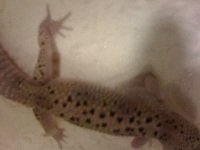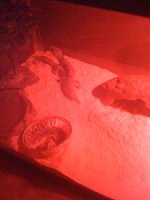AlexaG
New member
Hey all, I was just wondering if any one can help me with this new issue;
I've had my Tangerine carrot-tail baldy for about 3 years now. And she has shed countless times with out any issues.
However, this morning while I was washing out their dishes and replacing them with new ones, I realized she was in mid shed. The skin that was peeling off her was dry and brittle, so I assume it has been "flaking" off for a while. Also, my boyfriend mentioned that when he was feeding them last night that she was in shed...so I assume she has been in shed for a while...
Then I decided to pick her up, and put her in a small deli cup with some warm water in it. It usually helps with the shedding, but she wiggled out of my hands before I got her out of the tank. When I reached in a second time to get her, she nipped at me several times. I finally managed to get a good hold on her and placed her into the deli cup.
Thats when I realized, where she had already shed, there were bubbles underneath the skin. So the newer "fresh" skin had bubbles(blisters?) underneath it. They're behind her two front legs...
So I let her soak in the water for a few minutes...I removed her carefully and placed her back in her cage. She ran straight for the hide.
I checked on her a couple of hours ago; she had shed fully but the bubbles were still there...Help please? I might take her to a vet tomorrow if they dont go away... :[ Shes usually timid and sweet and gives me little gecko kisses when i pick her up...but she acted so strangely...I hope she isn't in too much pain.
I will post pictures if anyone needs them. Thank you so much!!
I've had my Tangerine carrot-tail baldy for about 3 years now. And she has shed countless times with out any issues.
However, this morning while I was washing out their dishes and replacing them with new ones, I realized she was in mid shed. The skin that was peeling off her was dry and brittle, so I assume it has been "flaking" off for a while. Also, my boyfriend mentioned that when he was feeding them last night that she was in shed...so I assume she has been in shed for a while...
Then I decided to pick her up, and put her in a small deli cup with some warm water in it. It usually helps with the shedding, but she wiggled out of my hands before I got her out of the tank. When I reached in a second time to get her, she nipped at me several times. I finally managed to get a good hold on her and placed her into the deli cup.
Thats when I realized, where she had already shed, there were bubbles underneath the skin. So the newer "fresh" skin had bubbles(blisters?) underneath it. They're behind her two front legs...
So I let her soak in the water for a few minutes...I removed her carefully and placed her back in her cage. She ran straight for the hide.
I checked on her a couple of hours ago; she had shed fully but the bubbles were still there...Help please? I might take her to a vet tomorrow if they dont go away... :[ Shes usually timid and sweet and gives me little gecko kisses when i pick her up...but she acted so strangely...I hope she isn't in too much pain.
I will post pictures if anyone needs them. Thank you so much!!




